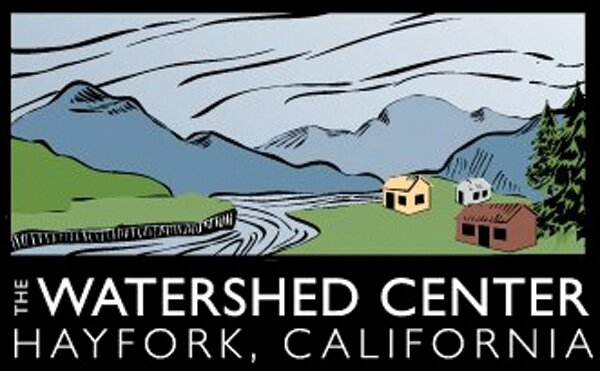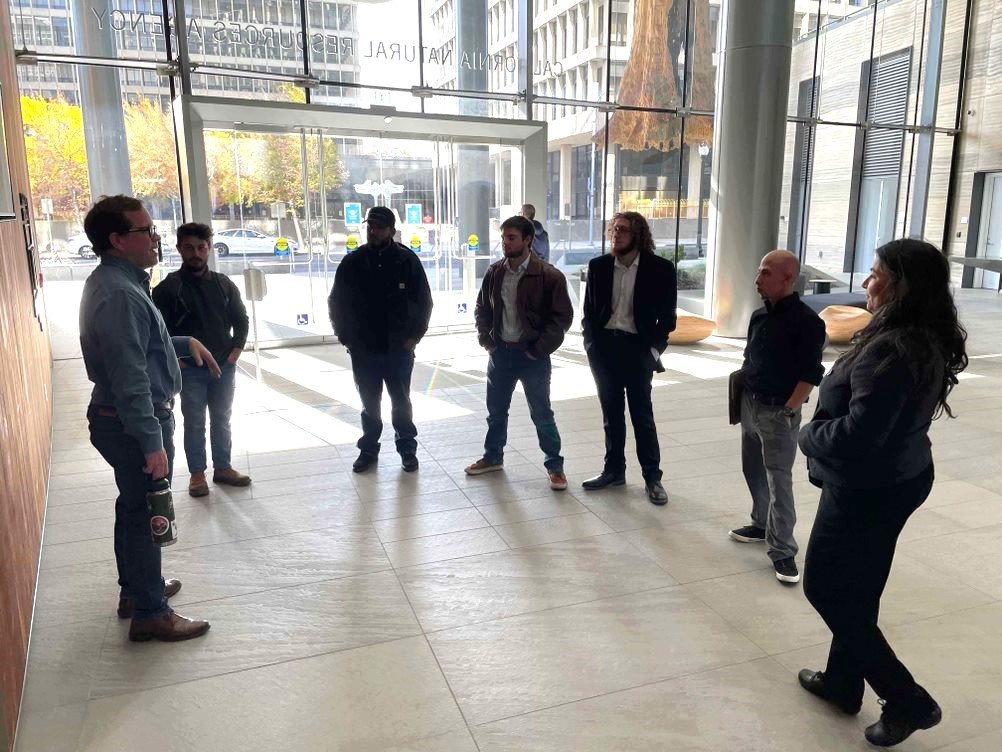The Watershed Research and Training Center Partners with Local Conservation Corps to Build California’s Wildfire Resilience Workforce
Up to $760,000 in Awards to Enable Underrepresented Communities Access to Wildfire Resilience Trainings and Mentorship Opportunities
OCTOBER 2023
The Watershed Research and Training Center (The Watershed Center) is launching a new kind of workforce development effort, specifically tailored to corpsmembers of Local Conservation Corps across California. The Watershed Center piloted this approach from January 2022 to August 2023 with Conservation Corps North Bay, using funds from the California Department of Conservation’s (DOC) Regional Forest and Fire Capacity (RFFC) Program. Now, thanks to continued RFFC funding and also a grant from CAL FIRE’s Workforce Development grant program, the Watershed Center is scaling up the effort.
Cascada Ervin, RFFC Priority Populations Program Manager, trains Conservation Corps North Bay corpsmembers in safe tree-felling practices.
”When I think of firefighter[s], I think of […] people who have money and guidance from other family members who have been in the fire service, and I didn’t have that. I’ve been homeless […], but being here, it definitely showed me it’s not what I thought, and it built my confidence up to actually think about a career in fire.” —Pilot Training Participant
The DOC’s RFFC program seeks to increase regional capacity to prioritize, develop, and implement forest and wildfire resilience projects. “Most other RFFC grantees work in a specific region of the state, whereas the Watershed Center's RFFC program is statewide in nature. We focus on technical capacity building, peer networking to advance the dissemination of best practices, and coordinating the other RFFC grantees. Some of our technical capacity building is focused on offering workforce development opportunities to underrepresented and underserved communities in California, who we refer to as ‘priority populations,’” the Watershed Center’s RFFC Program Director Allison Jolley states.
Jolley continues, “Our RFFC priority populations work involves partnering with several Local Conservation Corps throughout the state, and supporting their corpsmembers in navigating wildfire resilience career paths. We do this through offering a four-module curriculum to corpsmembers, followed by a long-term mentorship and job shadowing opportunity.”
“The Watershed Center has been in the business of workforce development for 30 years. We believe that workforce development is more than formal trainings, albeit those are critical. In addition to the six certificates each of the participants are eligible to earn, selected mentees are also offered all-expenses paid field trips/networking days. These experiences provide important hands-on training, and critical networking opportunities,” states Jolley. These photos show pilot mentees during a networking day with California state employees and other state leaders.
WHO WE’RE SERVING
The corpsmembers who receive this offering often face a range of obstacles to employment, rooted in systemic issues such as intergenerational poverty, insufficient access to mental and physical health services, and/or are negotiating legal issues. Some have been underserved by the education system or find difficulty navigating systems designed for primary English speakers. Others may have experienced insecurity in food or housing. Partnering with these corpsmembers presents a unique opportunity to increase the diversity of the wildfire resilience workforce over time, while also increasing the entry-level wildfire resilience workforce’s capacity in the short term. By investing in the Corps’ capacity through training subawards, providing high-value training services and material support, these strategic investments provide excellent value to each individual.
Local Conservation Corps are unique in their focus on community-level service. In comparison to the state-level California Conservation Corps, Local Conservation Corps are much smaller organizations and typically work within daily commute distances of their crew headquarters. This means the Local Corps are more accessible to workers who may need to be home in the morning and evenings to care for dependents. The Local Corps sometimes also have less stringent entry requirements, and/or more flexibility in how long corpsmembers can stay in the program.
INDIVIDUAL AND ORGANIZATIONAL CAPACITY
In addition to investing in the leaders of tomorrow, this funding also builds capacity in Local Conservation Corps today, further empowering their ability to provide the boots-on-the-ground solutions desperately needed across the state. The certified chainsaw curriculum gives the corps greater ability to take on chainsaw work with new partners or in new jurisdictions. The fire practitioner training offered qualifies corpsmembers as National Wildfire Coordinating Group (NWCG) Firefighter II, allowing them to take on fire-use projects requiring these qualifications. “In other words, we are preparing Local Conservation Corps to be another force in the use of beneficial fire to restore California's ecosystems,” states Cascada Ervin, Priority Populations Program Manager at the Watershed Center.
Training materials, including those offered in Spanish like this National Wildland Fire Coordinating “Group Incident Response Pocket Guide,” or “Guía de Bolsillo de Respuesta a incidentes” in Spanish, are critical to our offerings. Thanks to our responsive and flexible funders at the DOC and CAL FIRE, we are able to equip participants with the materials they need to succeed in both the classroom and field portions of our training.
Four Modules, One Goal
As mentioned above, our Priority Populations training offering entails four training modules, followed by a mentorship program. “In developing our curriculum for these trainings, I thought about all the things I wished someone had told me prior to my first day of wildland firefighting training,” states Cascada. This led to the Watershed Center’s development of two proprietary training modules, designed to give participants greater insight into what kind of careers this workforce includes, and how, and why, they could fit into that workforce. That first module is called “Workforce Development.” Module 2, “Navigating Barriers to Employment,” provides useful tools and dialogue on overcoming corpsmembers’ perceived barriers to establishing a career in wildfire resilience work.
Leadership skills are also a key takeaway in the training curriculum. Corpsmembers are empowered to speak, provide feedback, challenge instructors, and think outside-the-box about how their unique lived experience can be an asset to career growth. Modules 3 and 4, “Basic Fire Practitioner Training” and “Chainsaw Proficiency,” are projected to equip 180 corpsmembers or crew leaders with 44-68 hours of NWCG-equivalent training, including certificates such as S-130 (Firefighter Training), S-190 (Introduction to Wildland Fire Behavior), and S-212 (Wildland Fire Chainsaws) among others.
During our pilot training, several corpsmembers noted that this was their first formal leadership opportunity in the workplace.
“It’s critical that we slow down and invest in our entry-level workforce, especially if members of that workforce are from communities that are currently underrepresented in leadership roles related to wildfire resilience. If we do this right, those folks will be our future planners, program directors, and policy leaders. It’s only then, when we have diversity at the highest levels of leadership within all sectors of wildfire resilience, that we will see underrepresented communities’ interests and needs appropriately understood and prioritized.”—Allison Jolley, WRTC RFFC Program Director
By engaging and supporting workers in the early stages of their careers, this effort is able to impact career trajectory, hopefully retaining promising and hardworking individuals within the greater wildfire resilience field in the long term. By offering them the skills and foundational knowledge they need, corpsmembers will be empowered to take the next step in their careers and become the resilience leaders of tomorrow.
Mentorship
In addition to these training experiences, up to 40 participants will be selected over the next two years to receive individualized career mentorship. Participants selected for personalized mentorship are also offered in-person experiences designed to provide on-the-job training or shadowing, giving mentees a chance to experience new, and sometimes unexpected, career inspiration and opportunities.
Mentorship opportunities in the past included habitat restoration, tree nursery operations, prescribed fire, and Community Wildfire Protection Planning (CWPP) events. When asked which activity was the most impactful, pilot mentees agreed that it was the CWPP meeting. As their prior working experience was mostly field-based fuel reduction, it was eye-opening to see where the ‘why’ of the work is born.
“Other companies don’t really have the same confidence [in] us. They just judge, but I appreciate everything you guys [have] done for us.”—Pilot training participant
“[Participants] really enjoy seeing the full picture of why we’re doing this, how people got here, what they can do next. We are so thankful that this opportunity is happening and [it] really opens our members’ eyes about no matter how many barriers they have, they can still do this. Now that they have this training, they are one step closer…”—Local Conservation Corps staff
What’s Next?
Currently, the Watershed Center is funding four Local Conservation Corps—the Conservation Corps of Long Beach, Los Angeles Conservation Corps, Conservation Corps North Bay, and the Urban Conservation Corps of the Inland Empire—and aims to fund three more by mid-2024 for a total of $760,000. These funds will cover corpsmembers’ time and travel to attend trainings and participation in mentorship. It also supports the Corps’ staff time in partnership with the Watershed Center in planning, implementation, and follow-up.
The training cadre includes in-house staff and highly experienced training specialists who were selected for their proven ability to train diverse audiences. The cadre includes The Ember Alliance, Life in the Wildlands, Torchbearr, and Wildfire Alignment Strategies, LLC.
The first training kicked off with corpsmembers from Long Beach Conservation Corps and Los Angeles Conservation Corps, at De Forest Park in Long Beach, California. In addition to receiving the four-part curriculum, they also networked with and learned from representatives from the Los Angeles County Fire Department, Tree People, California Native Plant Society, and the National Forest Foundation. After the training, one Corpsmember reported that it was a “great exploration/introduction to this career world. Showed me the pros [and] cons and how many paths there are.”
This in-depth approach is advancing the careers of almost 200 individuals, while also building the organizational capacity of California's Local Conservation Corps to perform additional wildfire-resilience projects.
To learn more about the Watershed Center’s Priority Populations work, including highlights from the 18-month pilot program with Conservation Corps North Bay, checkout this blog featured on the Fire Adapted Communities Learning Network’s website: Pathways for Priority Populations.
Cascada kicks off the first training with corpsmembers from Long Beach Conservation Corps and Los Angeles Conservation Corps in Long Beach, California.
Questions?
Allison Jolley
(510) 619-8341
allison@thewatershedcenter.com
Program Director
Regional Forest & Fire Capacity Program
The Watershed Research & Training Center
View a printer-friendly, PDF version of this article here.
The work upon which this publication is based was funded in whole or in part through a Regional Forest and Fire Capacity grant awarded by the California Department of Conservation, and by the California Department of Forestry and Fire Protection’s Business and Workforce Development Grants.







